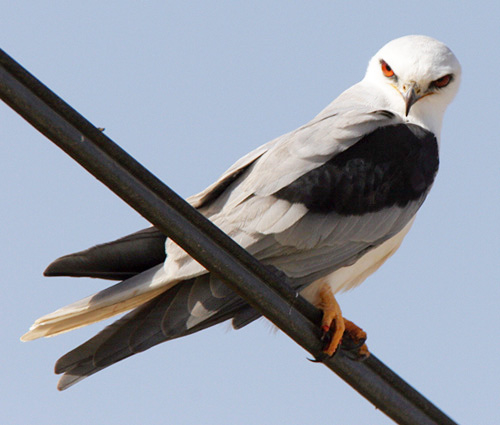No strings attached: the fierce white-tailed kite
 (Download Image)
Photo courtesy of Scott Streit The white-tailed kite (Elanus leucurus)
(Download Image)
Photo courtesy of Scott Streit The white-tailed kite (Elanus leucurus)
To spot this hawk, you might as well forget about the darkly colored raptor stereotype. While the white-tailed kite otherwise has features befitting these fierce predators including red eyes, a hooked beak and sharp talons, its generally bright white plumage is not typical of the Accipitridae or hawk family. Though the more typical black or brown raptor plumage provides a camouflaged appearance that allows for a stealthy swoop in the final hunt, the white-tailed kite has another trick up its feathers.
It’s all in the hover
The white-tailed kite keeps its hunting style distinctive by coupling its keen eyesight (four to eight times more acute than humans) with its unique hovering in place. Catching sight of this raptor hovering high above the ground is a riveting experience and that’s before its steep swoop to grab its prey (small mammals). There is no doubt that the white-tailed kite keeps the fearsome predator reputation of raptors intact.
Catch a glimpse of a hovering kite on YouTube and listen to its " whistled yelp ." Then watch the fields around the Lab and throughout Livermore and Springtown to record your own sighting of this protected (California Fully Protected Species; Migratory Bird Treaty Act) bird while vicariously experiencing the "thrill of the hunt."
The white-tailed kite experienced a dramatic population decline in the last century (1900s) due to human predation (shooting), and was nearly threatened with extinction. Thanks to protections put in place, its population both grew and spread, although with a patchy distribution. This species is found largely along the U.S. west coast as well as parts of Central and South America.
Shouldering a striking black patch
The long, narrow and pointed wings of the white-tailed kite often are held in a dihedral while soaring high above its habitats of grasslands and open woodlands. From below, the adults are mainly white, including their long tails, with gray-black primary feathers. Glimpsed while perched, its white face and red eyes contrast with mainly gray upper parts and distinctive black shoulder patches. While similar in coloration, fledged juvenile kites have a buffy wash over most of their body. With a length of approximately 15 inches and wingspan of more than three feet, this is considered a medium-sized raptor.
Living the high life
Often hidden high in tree canopies (20-50 feet up), spotting a white-tailed kite nest is not simple. The kites’ nests tend toward flimsy compared to other raptor nests, built out of twigs and lined with grasses rather than more substantial sticks. Nests may be used year after year with kites typically monogamous in their mating behavior and often paired for life. The female incubates typically four eggs for about a month, followed by defending and feeding her altricial (helpless and dependent) nestlings. The male hunts and retrieves food for the female and eventually for both her and the young. In about a month, the young may fly, though it will be another month before they can feed themselves.
Kite flying at the Lab
This unique bird may be especially visible during breeding season (January through May) though it also may be seen throughout the year. Take a bike ride along Greenville toward Tesla and this white-headed raptor with steely red eyes will intently watch from a high perch or while hovering above the adjacent grassland. Runners and walkers on Patterson Pass may see a swooping black-shouldered kite, chasing a squirrel nearby in the North Buffer Zone.
Outside of the breeding season, kites tend to roost communally in large groups (more than 100 birds). Yet because of their relatively small numbers and patchy population, observations of this behavior are rare in this region. Look to the sky to find a hovering kite high above the ground. You don’t need to know the intricacies of its plumage to feel a certain familiarity with this distinctive raptor.




